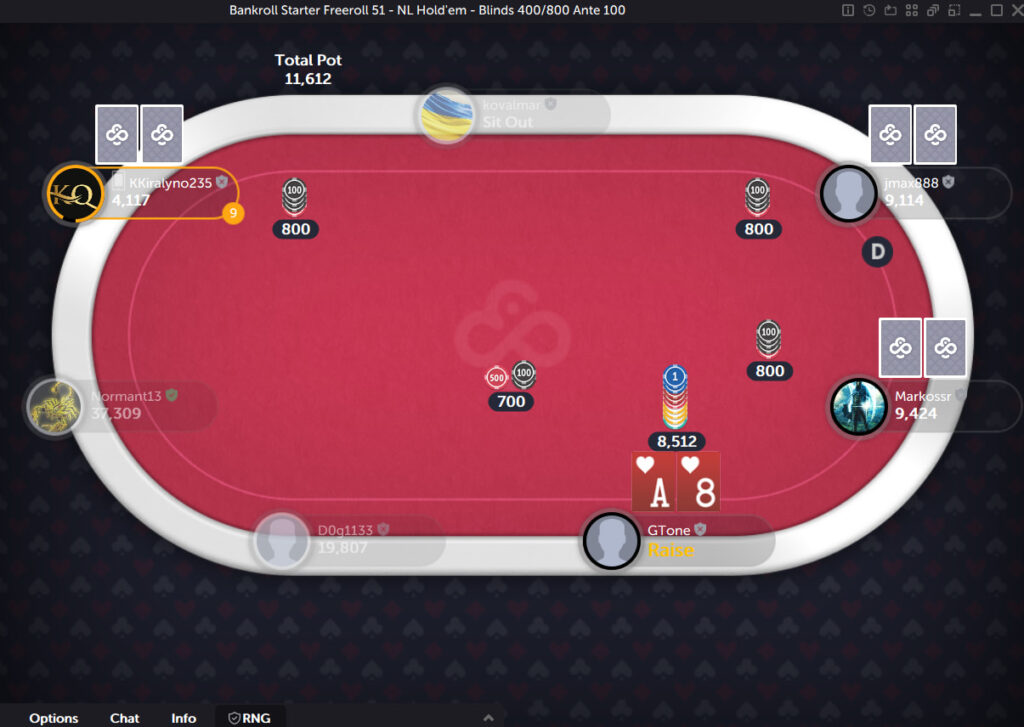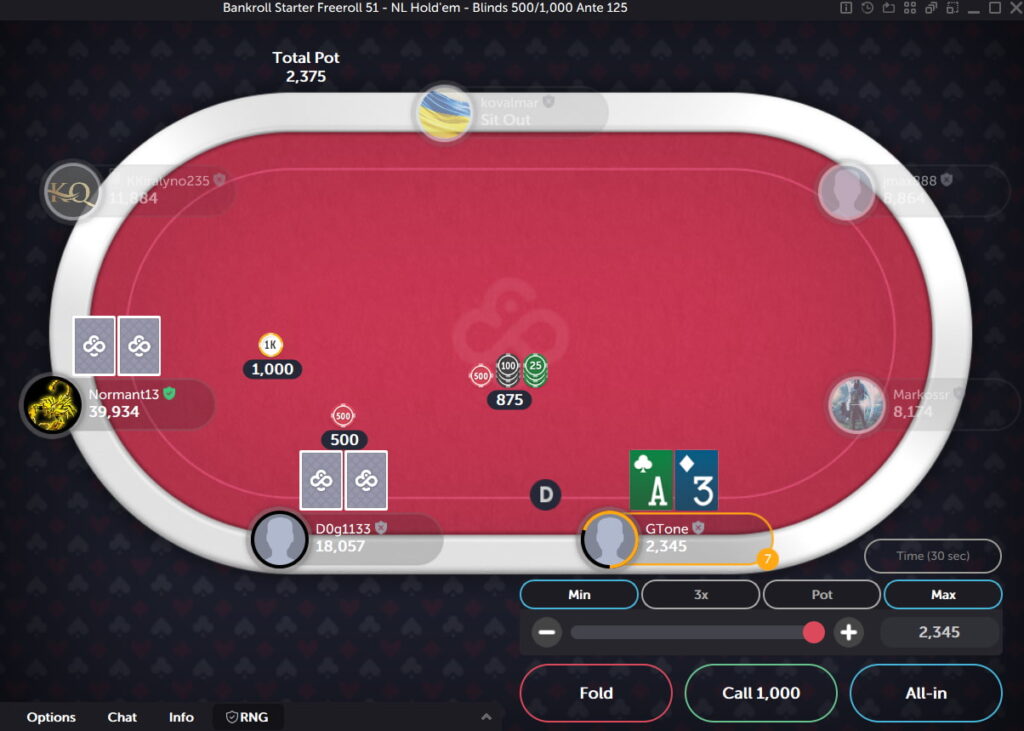Last Updated: 5 May 2025
Short Stack Poker: Essential Strategy Guide
Short stack poker isn’t just for beginners - even pros end up with small stacks at times. We’ll teach you the basics and how to build your stack back.
StrategyEver found yourself sweating with a dwindling stack, wondering if it’s time to push all-in or wait for a better spot? You’re not alone. Whether you’re grinding tournaments or playing cash games, mastering short stack poker isn’t just useful—it’s essential for survival.
At CoinPoker, we’ll show you how to turn those nerve-wracking moments into profitable opportunities. Don’t worry if you’ve struggled with short stack play before—by the end of this guide, you’ll have the confidence to navigate these tough situations like a pro.
What is Short Stack Poker?
When you’re playing poker with fewer chips than most of your opponents, this is the meaning of “short stacked.” But here’s the thing—being short-stacked isn’t about having the smallest stack at the table. It’s all about how many big blinds you have left to work with, and understanding this distinction is crucial for developing the right strategy.
Think of it this way: if you’ve got 100,000 chips but the blinds are 25,000/50,000, you’re actually short-stacked with just two big blinds (2bb). 100,000 sounds like a lot, but when the blinds are 50,000, you only have two.
Meanwhile, someone with 50,000 chips at a 500/1,000 blind level has a healthy 50 big blind stack (50bb). It’s all relative to the current blind level, and this relationship between your stack and the blinds dictates every decision you’ll make at the table.
Generally, here’s how we categorize stack sizes and what each means for your strategy:
- Micro stack (Less than 10 big blinds): Push or fold territory
- Short stack (10-20 big blinds): Primarily pre-flop decision making
- Medium stack (20-40 big blinds): Some limitations but still room for post-flop play
- Big stack (40+ big blinds): Full flexibility to make plays

Why is Short Stack Poker so Important?
Let’s face it—you’re going to find yourself short-stacked more often than you’d like, especially in tournaments. As blinds increase and the pressure mounts, even the best players frequently find themselves navigating short stack situations. Being able to play a short stack effectively isn’t just a nice skill to have—it’s the difference between bubbling and making the final table.
Consider this: In a typical poker tournament, you’ll spend about 30% of your time playing with less than 20 big blinds. That’s nearly a third of your tournament life where short stack skills directly impact your profitability. Master these situations, and you’ll dramatically improve your chances of deep runs and bigger paydays. Plus, in cash games, understanding short stack play helps you recognize and exploit the weaknesses of others who buy in short, turning their strategic limitation into your profit opportunity.
Short Stack Poker Strategy
Playing short stack poker requires a complete shift in mindset. Gone are the luxuries of fancy plays and tricky post-flop maneuvering. Instead, you’re entering a world where every chip matters and decisions become more mathematical than manipulative. This transition can feel uncomfortable at first, but embrace it—this simplified decision-making process can actually give you an edge over opponents who overcomplicate things.
Your primary focus should be on maximizing value with strong hands and minimizing losses with marginal ones. Here’s the foundation of solid short stack strategy:
- Tighten your starting hand requirements significantly.
- Increase your preflop aggression when you do play.
- Look for spots to get all-in preflop with strong hands.
- Minimize postflop decisions to reduce difficult spots.
- Focus on chip preservation without becoming too passive.
- Pay extra attention to position and stack sizes.
- Always be aware of stack-to-pot ratios.
This strategy requires discipline and patience—qualities that will serve you well throughout your poker career.

Hands to Play When Short Stacked
When you’re short on chips, you can’t afford to get cute with marginal hands. Your starting hand selection should focus on cards that play well in all-in situations. The shorter your stack, the more your hand selection should favor high-card strength over playability, as you’ll rarely see enough streets to realize the full potential of speculative hands.
Strong hands to play with 10-20 big blinds:
- Premium pairs (AA-JJ): Always play these aggressively
- Strong broadway cards (AK, AQ): Ideal for all-in situations
- Suited broadways (AKs-AJs, KQs): Strong equity when called
- Medium pairs (TT-88) in late position: Good shoving hands
When under 10 big blinds, expand to include:
- Small pairs (77-22): Great for shoving over limpers
- Any ace with a decent kicker (AJ-A9): High card equity
- Suited connectors (T9s-76s) in late position: Only when antes are in play
Remember: The shorter your stack, the more willing you should be to get all your chips in preflop with these hands. Each hand’s value changes dramatically based on your position and the tendencies of players yet to act. A hand that’s an easy shove against tight players might be an easy fold against calling stations.
Always Consider Your Position as a Short Stack
Position becomes even more crucial when playing short stack poker. Late position gives you maximum information and the ability to put pressure on opponents who’ve shown weakness. The power of position amplifies when you’re short-stacked because you have fewer chips to make mistakes.
Early Position:
- Play only your strongest hands (AA-QQ, AK).
- When you do play, be prepared to get all-in.
- Avoid limping—raise or fold.
- Consider the stack sizes of players behind.
- Factor in the likelihood of multiple callers.
Middle Position:
- Slightly wider range than early position.
- Look for opportunities to steal blinds.
- Be ready to re-shove over late position raises.
- Pay attention to active players left to act.
- Watch for aggressive three-bettors.
Late Position:
- Most profitable spot for short stack play.
- Aggressive steal attempts when folded to.
- Wider range for all-in moves.
- Take advantage of fold equity.
- Consider blind defenders’ tendencies.
Button play deserves special attention—it’s your most profitable position and where you should take the most aggressive lines with marginal hands.
Carefully Choose Your Spots
With a short stack, every decision can be your last. There’s nothing wrong with this and every player faces it, but must give yourself the best shot you can. That means spot selection becomes critical. The key is recognizing which situations offer the best combination of fold equity and showdown value when called. Understanding these dynamics helps you maximize your chances of survival and chip accumulation.
Tournament Considerations:
- Proximity to money bubbles
- ICM pressure on other players
- Stack sizes of players yet to act
- Previous action patterns
- Tournament payout structure
Cash Game Factors:
- Table dynamics and current playing styles
- Players’ tendencies to call light
- Your table image and recent history
- Stack sizes relative to the pot
- Previous hands and metagame considerations
Learn to recognize when the math and circumstances align in your favor. Sometimes, the best spots aren’t about having the strongest hand, but rather identifying when your opponents are least likely to contest your aggression.

Don’t Limp or Pursue Weak Draws
When you’re short-stacked, limping is like throwing chips away. Every chip you invest needs to have a clear purpose, and limping rarely accomplishes anything except weakening your stack further. You’re either strong enough to raise or weak enough to fold—there’s rarely a middle ground. Similarly, chasing draws becomes a luxury you can’t afford when every bet represents a significant portion of your stack.
Why Limping Hurts:
- Gives opponents great pot odds to see flops
- Doesn’t build the pot when you have strong hands
- Makes your stack size even more awkward post-flop
- Reveals weakness in your range
- Encourages multiple players to see a flop
- Reduces your fold equity on later streets
- Makes post-flop play more difficult
Better Alternatives to Limping:
- Raise or fold pre-flop with clear intention
- Push all-in with drawing hands that have good equity
- Look for spots to steal blinds with authority
- Make your raise sizes consistent to disguise hand strength
- Focus on hands that can win without improvement
- Maintain aggression with your continuing range
Be Cautious Bluffing or Stealing Blinds
While blind stealing is important, you need to be selective. Your stack size means failed bluffs can cripple you, while successful steals only give small gains. The key is identifying spots where your steal attempts are most likely to succeed and avoiding situations where you’re likely to face resistance.
Good Stealing Spots:
- Tight players in the blinds
- When antes are in play
- Against players protecting their stacks
- When shorter stacks have already folded
- After aggressive players have recently shown down bluffs
- During bubble periods in tournaments
- When your image is tight
Poor Stealing Spots:
- Against loose-aggressive players
- When multiple short stacks are behind
- Against players who frequently 3-bet
- After you’ve been caught bluffing recently
- When big stacks are in the blinds
- Against players defending blinds aggressively
- When your table image is loose
Defend Your Blind Far Less
When short-stacked, defending your blinds becomes a luxury you often can’t afford. The “defend wide” strategy that works with a deep stack can spell disaster when you’re short. Playing out of position with a compromised stack size forces you into numerous difficult decisions that can lead to bleeding chips.
Problems with Blind Defense:
- Playing out of position post-flop
- Committing too much of your stack
- Difficult post-flop decisions
- Limited maneuverability
- Can’t realize full hand equity
- Prone to facing continued aggression
- Stack-to-pot ratio problems
Instead of Always Defending Your Blinds:
- Look for re-shoving opportunities with strong hands
- Fold most marginal hands to preserve stack
- Save chips for better spots in position
- Focus on hands with good all-in equity
- Consider ICM implications in tournaments
- Watch for players exploiting your tighter defense
- Be willing to give up your blind when the math dictates
Short Stack Poker Tournament Strategy
Tournament short stack poker play differs significantly from cash games. In tournaments, you’re dealing with increasing blinds, ICM considerations, and the constant threat of elimination. Understanding these unique dynamics is crucial for maximizing your tournament success.
Key Tournament Adjustments:
- Opportunities to Make a Move Near Bubbles When Short: When you’re near the bubble, short stacks have a significant advantage in that many players are more conservative in their play, focusing on survival to reach the money. This provides opportunities to exploit their passivity with well-timed aggression.
- Increased Emphasis on Survival with Medium Stacks: Having a medium stack allows for flexibility, but it also means you’re not as pressured as short stacks. Survival becomes key here, as you need to avoid unnecessary risks while still positioning yourself to accumulate chips when opportunities arise.
- Must Account for Pay Jumps and ICM Pressure: In tournament poker, each decision must consider the Independent Chip Model (ICM), as the value of your chips increases as you approach higher pay jumps. You must adapt your strategy accordingly to preserve your stack and maximize returns as the payouts grow.
- Different Value of Chips Based on Tournament Stage: Early in the tournament, chips have relatively low value compared to later stages when they represent more potential for a higher payout. Understanding when to take more risks for accumulation and when to be conservative is key in ensuring you’re not eliminated before the money.
- Importance of Accumulation Periods: In tournaments, there are times when chip accumulation becomes critical—especially in the middle stages. These are periods when you can build your stack before the blinds increase too much and without the pressure of nearing the bubble. This period allows you to take calculated risks to increase your chip stack, giving you more leverage to survive and thrive in later stages.
- Ladder-Up Considerations: As you progress through the tournament, the concept of “laddering up” becomes important. This refers to the gradual increase in your payout as you move closer to higher finishing positions. A player must weigh the risk versus reward of making big moves based on the ladder structure, with consideration for how many players are left, how many remain in contention for a payout, and how much more aggressive you can afford to be in order to climb the ladder without risking premature elimination.
- Stack Preservation vs. Chip Accumulation Balance: Balancing the preservation of your stack with the need for accumulation is crucial in tournament poker. You want to avoid getting caught in a situation where your stack becomes too small to be competitive, while also looking for opportunities to accumulate chips at optimal moments when the risk is low, and your payout prospects are good.
The key is understanding when to shift gears between preservation and accumulation modes. Your strategy should adapt not just to your stack size, but to the tournament stage and the tendencies of your opponents.
Learn Push/Fold Ranges for Tournaments
When your stack drops below 10 big blinds in tournaments, your strategy often reduces to push or fold decisions. This simplification can actually be an advantage if you understand optimal ranges and exploit your opponents’ tendencies to adjust incorrectly.
Push with:
- Any pair, regardless of position
- Any ace, with position consideration
- King-ten suited or better
- Queen-jack suited or better
- Connected cards nine and higher
- Any two Broadway cards
- Suited connectors in late position
- Any hand when ICM pressure dictates
Fold with:
- Weak suited connectors
- Small offsuit cards
- Weak aces in early position
- Speculative hands out of position
- Hands with poor equity when called
- When facing multiple all-ins ahead
Understanding these ranges isn’t enough—you need to adjust them based on your opponents’ calling ranges and tournament situation. Pay special attention to stack sizes behind you and how different players respond to aggression.
Short Stack Poker Mistakes to Avoid
Even experienced players make these common short stack poker mistakes, but understanding and avoiding them can dramatically improve your results. The key is recognizing these errors before they cost you chips and developing strategies to prevent them.
Common Mistakes and Solutions:
- Waiting too long to make moves
- Learn to act before desperation sets in
- Recognize profitable spots early
- Don’t let blinds eat away your stack
- Playing too many marginal hands
- Stick to premium holdings
- Avoid speculative hands
- Focus on high-card strength
- Calling off too light
- Understand proper calling ranges
- Account for ICM implications
- Consider stack sizes carefully
- Not adjusting to opponent tendencies
- Study how opponents react to short stacks
- Track calling frequencies
- Adapt your ranges accordingly
- Mismanaging stack sizes
- Maintain awareness of effective stacks
- Plan ahead for blind increases
- Keep track of opponent stack depths
Additional Critical Errors:
- Overvaluing small pairs in multi-way pots
- Ignoring ICM implications in crucial situations
- Playing too passively when action folds to you
- Poor position play with marginal holdings
- Failing to account for stack sizes behind you
Practice Your Short Stack Strategy Here
Ready to put these strategies into action? CoinPoker offers the perfect environment to hone your short stack skills. With our diverse range of tournaments and cash games, you’ll find plenty of opportunities to practice these techniques in real-world situations.
Join us at CoinPoker today and turn your short stack weakness into a strength.
FAQs
A short stack refers to having relatively few chips compared to the blind levels, typically less than 20 big blinds. This situation requires specific strategies and adjustments to play optimally.
Focus on playing premium hands aggressively, avoid fancy plays, and look for spots to get all-in pre-flop with strong holdings. Maintain strict discipline with starting hand selection and position play.
Most cash games allow a minimum buy-in of 20 big blinds, though some may require 40 or more. Check specific table rules as minimums can vary by poker room and stake level.
No, you should push all-in based on your hand strength, position, and opponent tendencies. Consider factors like stack sizes behind you, tournament stage, and player calling ranges before making this decision.
Look for spots to double up with premium hands, steal blinds when possible, and avoid marginal situations that could further damage your stack. Patience and selective aggression are key to rebuilding.
Explore More
Announcements
Read recent announcements from CoinPoker about new games, ambassadors, and changes to our platform.
8 PostsGuides
The go-to resource for mastering poker with expert tips and strategies. Whether you're a beginner or a pro, our guides will elevate your skill level.
60 PostsNews
Find the latest poker news from CoinPoker, plus our latest CoinPoker Weekly and Monthly Newsletters. Updates about games, promotions and other exciting crypto news.
90 PostsPromotions
Find the latest coinpoker promotions here. Explore the crypto poker world with the best poker promotions available.
1 Post
















